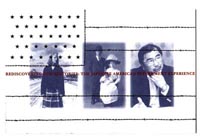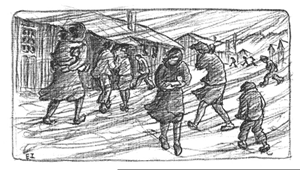

 
|
|
Rediscovering Our History:
The Japanese American Experience

|
The following two activities using video are from Rediscovering Our History: The Japanese American Internment Experience - A comprehensive video and curriculum package by NAATA which includes 3 videos: Days of Waiting, Family Gathering, and A Personal Matter: Gordon Hirabayashi vs the U.S.; study guides for each; Teacher’s Guide: "The Bill of Rights & the Japanese American World War II Experience"; and "Introductory Guide" by Gary Mukai, Director of the Stanford Program on International and Cross-Cultural Education.
For the video package order information, click here.
ACTIVITY 1
The following activity is based on Days of Waiting, the Academy Award-winning documentary by Steven Okazaki. The film documents the life and art of Estelle Ishigo, the Caucasian wife of nisei Arthur Ishigo. Her journal entries and artwork convey a vivid sense of the internees’ daily lives and the deep impact of exclusion and incarceration.
Art print and haiku activity
As a group, develop two or three haiku poems that capture the emotions of this scene from Heart Mountain. Haiku is written in three lines of 5 syllables, 7 syllables, and 5 syllables.

Illustration by Estelle Ishigo.
ACTIVITY 2
(Recommended for middle school through college and community audiences.)
This discussion is based on the Academy Award nominated film by Lise Yasui, Family Gathering,a deeply personal look at the effects of the World War II evacuation and internment of Japanese Americans on one family. It is told from the perspective of a third-generation Japanese American who grew up with little understanding of her ethnicity or the traumas experienced by her family during the 1940’s. The film focuses on her grandfather, Masuo Yasui, who, after 30 years in the U.S., was arrested by the F.B.I. as a "potentially dangerous" enemy alien after the Japanese attackon Pearl Harbor.
Post-Viewing Discussion and Questions
- Constitutional Issues and the History Behind a Political Decision:
Remind students that the decision to intern Japanese Americans was the result of long-standing prejudice against Asians. Many political, social, and economic factors led to the government’s decision. Discuss these factors as revealed by the film.
Why do you think the government did not intern people of German or Italian ancestry?
Discuss this statement:
"You may think that the Constitution is your security — it is nothing but a piece of paper. You may think that the statutes are your security — they are nothing but words in a book. You may think that elaborate mechanism of government is your security — it is nothing at all, unless you have sound and uncorrupted public opinion to give life to your Constitution, to give vitality to yourstatutes, to make efficient your government machinery."
— Chief Justice Charles Evans Hughes
Discuss which rights guaranteed under the Bill of Rights and the Constitution were violated as a result of Executive Order 9066. (Seven of the ten Articles of the Bill of Rights were abrogated: Article I: freedom of religion, freedom of speech, freedom of the press, right to assemble; Article II: right to keep and bear arms; Article IV: freedom from unreasonable searches and seizures; Article V: right to an indictment or to be informed of the charges; right to life, liberty, and property; Article VI: right to speedy and public trial, right to be confronted with accusatory witnesses, right to call favorable witnesses, right to legal counsel; Article VII: right to trial by jury; Article VIII: right to reasonable bail, freedom from cruel and unusual punishment. Further Constitutional guarantees violated were: right against involuntary servitude, right to equal protection under the laws, right to vote, right to habeas corpus.)
Ask students if they think the government’s decision to apologize for the internment and offer financial compensation is necessary or fair. Discuss arguments on multiple sides of the issue: some say that what happened to the Japanese could happen to anyone, that "the fight for Redress was for all Americans." Others claim that "Blood is Thicker than Water" — that given the circumstances of war, that the government’s suspicion of Japanese Americans was warranted. Others claim that such an act is merely a symbol since no amount of money can properly redress the wrongs committed by the government. Still others wonder if it is fair to make redress to one particular group, when there are instances of similar injustices imposed on many other groups. (i.e., should the government make similar official apologies and redress to African Americans whose families were subjected to slavery?)
What do those statements mean? Hold a debate, one side for redress and reparations, the other side opposed and another considering the more complex middle ground of its implications for American society as a whole.
Copyright. All rights reserved. NAATA (for Days of Waiting Study Guide) and Lise Yasui (Family Gathering). Contact NAATA for permission to reproduce for classroom or other use. All credits and copyright notice must appear on all copies. Contact NAATA for information: distribution@naatanet.org.
|
|
|

